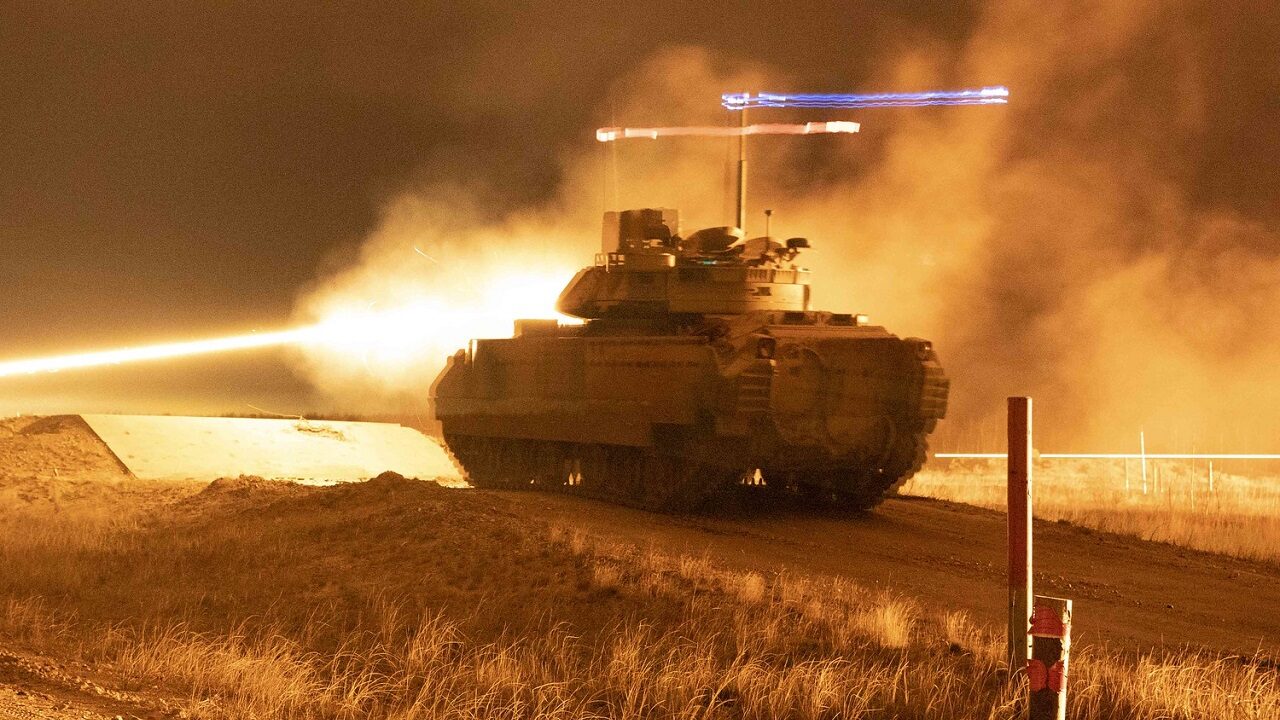Meet the Bradley Fighting Vehicle: The Army is surging forward with its Optionally Manned Fighting Vehicle, a next-generation infantry carrier described as a Bradley replacement for the future.
The OMFV, as it’s called, is being designed to deliver a nine-man squad into combat under armor using advanced, AI-enabled computing, new levels of autonomy, manned-unmanned teaming, and a new generation of weapons to include firepower and the ability to launch and recover drones.
The Life of Bradley Fighting Vehicle
The OMFV efforts are showing promise and demonstrate great importance to the Army, yet at the same time, the service is still operating upgraded variants of its classic, combat-tested, decades-old Bradley Fighting Vehicle.
There is a paradoxical quality to the Army’s continued Bradley upgrades, as there are both massive improvements and limitations that drive the need for the OMFV. Essentially, a legacy platform such as the Bradley can only be upgraded to a certain extent before “size, weight and power” constraints limit upgrade possibilities. Future combat vehicles, for example, will need new levels of onboard electrical power, electronic weapons (EW), and space for soldiers and ammunition. The Bradley has, over the years, been upgraded so many times that it has essentially “maxed out” and reached its limit.
Some survivability enhancements needed to counter threats in Iraq wound up maxing the Bradley’s weight and on-power capacity. For instance, Army developers explain that equipping the Bradley with new suspension, reactive armor tiles, and APS can increase the vehicle’s weight by as much as 3,000 pounds.
However, this is not to say the most cutting-edge Bradley variants are not extremely useful and impactful. As recently as several years ago, the Army purchased 473 of the most modern Bradley M2A4 and M7A4 vehicles, platforms with new computing, weapons sights, digital processors, and long-range sensors.
Army weapons developers have told Warrior Maven that the newest Bradley A4s include upgrades to the engine and transmission, cooling system modification, electrical system upgrades, and the introduction of vehicle diagnostics. The upgrades, as explained by Army weapons developers, “bought back” some of the lost mobility and added the technical infrastructure sufficient to accommodate new weapons and sensors. Electronics and communications systems as they emerge.
Bradley Fighting Vehicle A5 is “Lethality Upgrade”
Building upon this progress, the Army has also in recent years been progressing quickly on its new Bradley A5 variant possibly armed with lasers, counter-drone missiles, active protection systems, vastly improved targeting sights, and increased onboard power to accommodate next-generation weapons and technologies.
Designed to be lighter weight, more mobile, and much better protected, emerging Bradley A5 lethality upgrades are part of a plan to build upon improvements with the A4.
More on-board power can bring the technical means to greatly support advanced electronics, command and control systems, computing power, sensors, networks, and even electronic warfare technologies.
Several years ago, Maj. Gen. David Bassett, former Program Executive Officer for Ground Combat Systems, (Bassett now directs the Defense Contract Management Agency) explained the upgrades in terms of A3 and A4 focusing upon the Bradley from the turret ring down – leading the A5 effort to more heavily modernize Bradley systems from the turret up. This includes weapons sights, guns, optics, next-generation signals intelligence, and even early iterations of artificial intelligence and increased computer automation.
The improved weapons sights on the Bradley A5 include 3rd-Generation Forward Looking Infrared Sensors and Commanders and Gunners sights. The A5 is also being built with added armor protection and ammunition storage as well as a technology referred to as “spot trackers” for dismounted soldiers.
Time for Lasers?
Also, while Army Bradley developers have not specifically said they planned to arm Bradleys with laser weapons, such innovation is well within the realm of the possible. Active Protection Systems also figure prominently in this equation, as they can draw upon advanced computing and fire control to find, track and intercept incoming anti-armor weapons and RPGs.
APS systems, targeting sights, and lasers can all also be integrated with Short Range Air Defense possibilities. SHORAD, as it’s called, is an air defense program arming Stryker vehicles with HELLFIRE and stinger missiles to bring the ability to track and destroy enemy drones, helicopters, and low-flying fixed-wing platforms.
The emergence of these weapons for the Bradley, and the fast-changing threat calculus is also, quite naturally, impacting what Army developers call CONOPS, or Concepts of Operations. Longer range sensors and weaponry, of course, can translate into a more dispersed combat area – thus underscoring the importance of command and control systems and weapons with sufficient reach to outrange attacking forces.
The idea of bringing more lethality to the Bradley is not only based upon needing to directly destroy enemy targets but also fundamental to the importance of laying down suppressive fire, enabling forces to maneuver in combat.
MORE: World War III – Where Could It Start?
MORE: A U.S.-China War Over Taiwan Would Be Bloody
Kris Osborn is the Military Affairs Editor of 19FortyFive and President of Warrior Maven – Center for Military Modernization. Osborn previously served at the Pentagon as a Highly Qualified Expert with the Office of the Assistant Secretary of the Army—Acquisition, Logistics & Technology. Osborn has also worked as an anchor and on-air military specialist at national TV networks. He has appeared as a guest military expert on Fox News, MSNBC, The Military Channel, and The History Channel. He also has a Masters Degree in Comparative Literature from Columbia University

